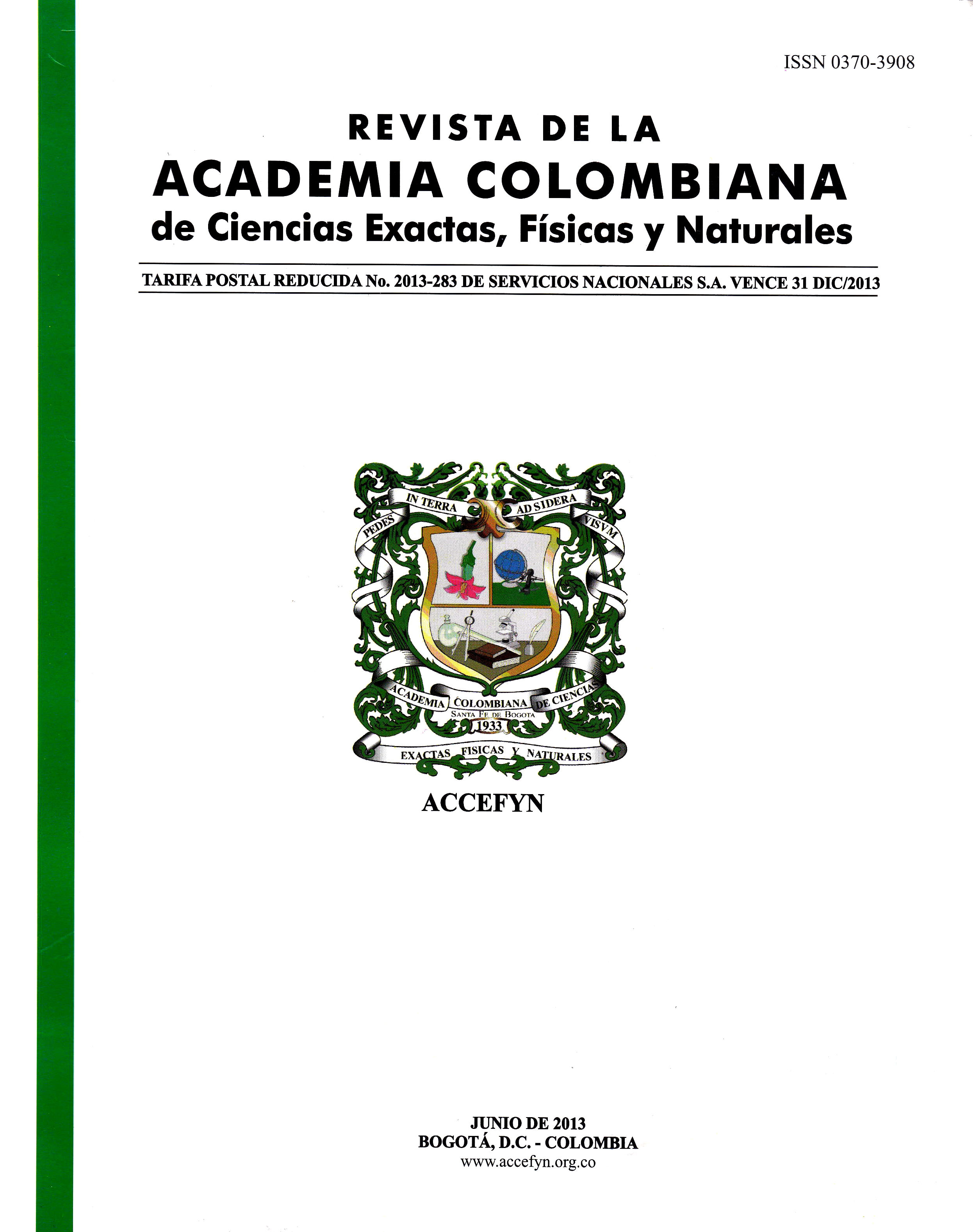Abstract
Hypsiboas lanciformis is a tree frog belonging to the albopunctatus group. Its distribution ranges from Bolivia, Brazil, Peru to Colombia and Venezuela. We studied the status of a population inhabiting the realms property of Complejo Uribante-Caparo, CORPOELEC, in Táchira state (southwestern Andean Venezuela), by monitoring their call and visual detection across transects, gathering information on their abundance; available space, and other natural history accounts. The abundance decreases as the dry season progresses, while individuals show an aggregate spatial arrangement. Individuals were vocalizing at the edges of secondary forest adjacent to disturbed areas. This species is sympatric with the hylids Hypsiboas pugnax and Scinax manriquei. Some individuals revealed the presence of ectoparasites and endoparasites that might be affecting the species’ survivalship.
Keywords
References
Ataroff, M. & L. Sarmiento. 2004. Las unidades ecológicas de los Andes de Venezuela. Pp: 9-26 En: La Marca, E. y P. Soriano (eds.). Reptiles de Los Andes de Venezuela. Fundación polar, codepre – ULA, Fundacite – Mérida, Biogeos, Mérida, Venezuela.
Azevedo-Ramos, C., E. La Marca, L.A. Coloma & S. Ron. 2004. Hypsiboas lanciformis. In: IUCN 2007. 2007 IUCN Red List of Threatened Species. .
Barrio, C. 1998. Sistemática y Biogeografía de los Anfibios (Amphibia) de Venezuela. Acta Biologica Venezuelica. 18(2):1-93.
Barrio Amorós, C. L. 2004. Amphibians of Venezuela Systematic List, Distribution and Referentes, An Update. Rev. Ecol. Lat. Am. 9(3): 1-48.
Barrio, C. L., A. Orellana & R. Manrique. 1999. Geographic Distribution: Anura: Hyla lanciformis. Herpetological Review, 30(2): 106-107.
Cardoso, A. J. & J. Vielliard. 1990. Vocalizacoes de anfibios anuros de urrem Cruzeiro do Sul, Estado do Acre. Revista Brasileira de Biología, 50(1):229-242.
Chacón-Ortiz A., A. Díaz de Pascual & F. Godoy. 2004. Aspectos reproductivos y desarrollo larval de Hyla pugnax (Anura: Hylidae) en el Piedemonte Andino de Venezuela. Rev. Acad. Colomb. Cienc. 28(108): 391-402.
Cope, E.D. 1870. Eighth contribution to the herpetology of tropical America. Proceedings of the American Philosophical Society 11: 556.
Cortez-Fernández, C. 2005. Herpetofauna de la zona norte del Parque Nacional y Área Natural de Manejo Integrado Madidi (PNANMI - Madidi). Ecología en Bolivia, 40(2): 10-26.
da Silva, H.R. 1998. Phylogenetic relationships of the family Hylidae with emphasis on the relationships within the subfamily Hylinae (Amphibia: Anura). Ph.D. dissertation, Department of Systematics and Ecology, University of Kansas.
De La Riva, I. 1990. Lista preliminar comentada de los anfibios de Bolivia con datos sobre su distribución. An. Mus. Reg. Sci. Nat. Turino 8: 261-319.
Duellman, E. W. 1978. The Biology of an Equatorial Herpetofauna in Amazonian Ecuador. Ed. Linda Trueb. 1-352 pp.
Duellman, W.E. 2001. Hylid frogs of Middle America. Ithaca, NY: Society for the Study of Amphibians and Reptiles.
Faivovich, J., C. Haddad, P. Garcia, D. Frost, J. Campbell & W. Wheeler. 2005. Systematic Review of the frog family Hylidae with special reference to Hylinae: phylogenetic analysis and taxonomic revision. American Museum of natural history. Number 294, 240 pp.
Frost. D.R. 1985. Amphibian Species of the world. A taxonomic and geographical reference. Association of systematics collection. 732 pp.
Gascon, C. & O.S. Pereira. 1993. Preliminary checklist of the herpetofauna of the upper rio Urucu, Amazonas Brazil. Rev. Brasil. Zool. 10(1):179-183.
Heyer, W.R. 1977. Taxonomic notes on frogs from the Madeira and Purus Rivers, Brasil. Papéis Avulsos de Zoología. 31(8):141-162.
ICZN. 1999. International code of zoological nomenclature, 4th ed. London: International Trust for Zoological Nomenclature.
Krebs, C. 1999. Ecological Methodology. Second edition. Ed. Vivian McDougal. Canada. 620 pp.
La Marca, E. 1992. Catalogo taxonómico, biogeográfico y bibliográfico de las ranas de Venezuela. Cuadernos Geográficos, Universidad de Los Andes. 1: 1-197.
La Marca, E. 1997. Lista actualizada de los anfibios de Venezuela. In: E. La Marca (ed), Vertebrados Actuales y Fósiles de Venezuela, pp. 103-120.
Museo de Ciencias y Tecnología de Mérida, Mérida.
Lynch, J. 2006. The amphibian fauna in the Villavicencio region of eastern Colombia. Caldasia 28(1): 135-155.
Péfaur, J. E. 1986. Estudio de la Calidad de agua del Embalse Uribante. Convenio MRNR. CADAFE. Facultad de Ciencias ULA. P:124 + Anexos.
Péfaur, J. E., & A. Díaz de Pascual. 1987. Distribución ecológica y variación temporal de los anfibios del estado Barinas, Venezuela. Rev. Ecol. Latinoamericana. 1(3-4): 9-19.
Rivero, J. A. 1971. Tres nuevos records y una nueva especie de anfibios de Venezuela. Carib. J. Sci., 2(1-2): 1-9.
Rodríguez, L.O. & W.E. Duellman. 1994. Guide to the frogs of the Iguitos region, Amazonian Peru. Asociación de Ecología y Conservación, Amazon Center for Environmental Education and Research and Natural History Museum, The University of Kansas, Lawrence, Kansas.
Ron, S. R. 2001. Anfibios de Parque Nacional Yasuní, Amazonía ecuatoriana. [referencia en línea]. Ver. 1.6 (28 de enero de 2008). Museo de Zoología, Pontificia Universidad Católica del Ecuador. Quito, Ecuador .
Ruiz-Carranza, P.M., M.C. Ardila-Robayo & J.D. Lynch. 1996. Lista actualizada de la fauna de Amphibia de Colombia. Revista de la Academia Colombiana de Ciencias Exactas, Físicas y Naturales. 20(77): 365-415.
Sierra N. 1989. Estructura de la comunidad zooplantonica del Embalse Uribante, Táchira. Tesis de grado para optar a la Licenciatura de Biología. Universidad de los Andes. Mérida, Venezuela. P: 163 + Anexos.
Wiens, J.J., J.W. Fetzner, C.L. Parkinson & T.W. Reeder. 2005. Hylid Frog Phylogeny and Sampling Strategies for Speciose Clades. Syst. Biol. 54(5):719-748.
Yerena, E. 1994. Corredores Ecológicos en los Andes de Venezuela. Parques Nacionales y Conservación Ambiental N° 4, editorial Torino, Caracas. P.XI + 186 + 1 mapa plegable: 12 figuras.

This work is licensed under a Creative Commons Attribution-NonCommercial-NoDerivatives 4.0 International License.
Copyright (c) 2023 Revista de la Academia Colombiana de Ciencias Exactas, Físicas y Naturales





